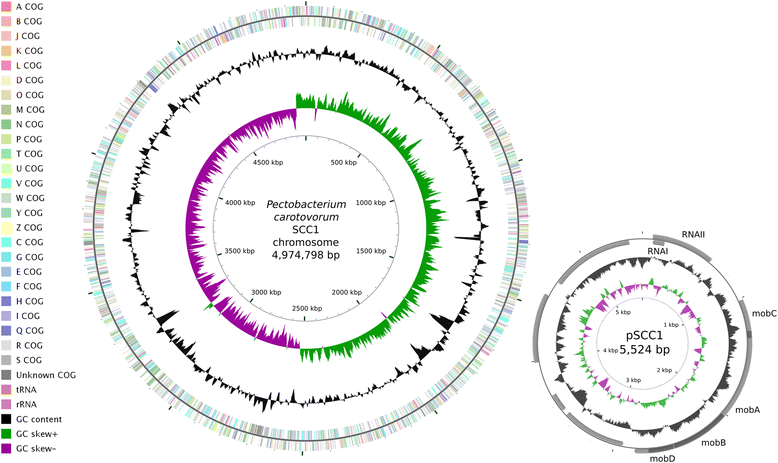Genome sequence of the model plant pathogen Pectobacterium carotovorum SCC1
- PMID: 29276572
- PMCID: PMC5738896
- DOI: 10.1186/s40793-017-0301-z
Genome sequence of the model plant pathogen Pectobacterium carotovorum SCC1
Abstract
Bacteria of the genus Pectobacterium are economically important plant pathogens that cause soft rot disease on a wide variety of plant species. Here, we report the genome sequence of Pectobacterium carotovorum strain SCC1, a Finnish soft rot model strain isolated from a diseased potato tuber in the early 1980's. The genome of strain SCC1 consists of one circular chromosome of 4,974,798 bp and one circular plasmid of 5524 bp. In total 4451 genes were predicted, of which 4349 are protein coding and 102 are RNA genes.
Keywords: Finland; Necrotroph; Pectobacterium; Plant pathogen; Potato; Soft rot.
Conflict of interest statement
The authors declare that they have no competing interests.Springer Nature remains neutral with regard to jurisdictional claims in published maps and institutional affiliations.
Figures



Similar articles
-
Pectobacterium carotovorum Phage vB_PcaM_P7_Pc Is a New Member of the Genus Certrevirus.Microbiol Spectr. 2022 Dec 21;10(6):e0312622. doi: 10.1128/spectrum.03126-22. Epub 2022 Nov 8. Microbiol Spectr. 2022. PMID: 36346243 Free PMC article.
-
New PCR-Based Assay for the Identification of Pectobacterium carotovorum Causing Potato Soft Rot.Plant Dis. 2022 Feb;106(2):676-684. doi: 10.1094/PDIS-08-21-1676-RE. Epub 2022 Feb 15. Plant Dis. 2022. PMID: 34569833
-
Complete Genome Sequence Resource for the Necrotrophic Plant-Pathogenic Bacterium Pectobacterium carotovorum WPP14.Plant Dis. 2021 Jan;105(1):196-198. doi: 10.1094/PDIS-05-20-1059-A. Epub 2020 Nov 17. Plant Dis. 2021. PMID: 32720879
-
Bacteriophages Isolated in China for the Control of Pectobacterium carotovorum Causing Potato Soft Rot in Kenya.Virol Sin. 2019 Jun;34(3):287-294. doi: 10.1007/s12250-019-00091-7. Epub 2019 Mar 13. Virol Sin. 2019. PMID: 30868359 Free PMC article.
-
Revised phylogeny and novel horizontally acquired virulence determinants of the model soft rot phytopathogen Pectobacterium wasabiae SCC3193.PLoS Pathog. 2012;8(11):e1003013. doi: 10.1371/journal.ppat.1003013. Epub 2012 Nov 1. PLoS Pathog. 2012. PMID: 23133391 Free PMC article.
Cited by
-
Pectobacterium parvum sp. nov., having a Salmonella SPI-1-like Type III secretion system and low virulence.Int J Syst Evol Microbiol. 2020 Apr;70(4):2440-2448. doi: 10.1099/ijsem.0.004057. Epub 2020 Feb 20. Int J Syst Evol Microbiol. 2020. PMID: 32100697 Free PMC article.
-
Comparative genomics of 84 Pectobacterium genomes reveals the variations related to a pathogenic lifestyle.BMC Genomics. 2018 Dec 7;19(1):889. doi: 10.1186/s12864-018-5269-6. BMC Genomics. 2018. PMID: 30526490 Free PMC article.
-
Single gene enables plant pathogenic Pectobacterium to overcome host-specific chemical defence.Mol Plant Pathol. 2020 Mar;21(3):349-359. doi: 10.1111/mpp.12900. Epub 2019 Dec 24. Mol Plant Pathol. 2020. PMID: 31872947 Free PMC article.
-
Genome-Wide Analyses Revealed Remarkable Heterogeneity in Pathogenicity Determinants, Antimicrobial Compounds, and CRISPR-Cas Systems of Complex Phytopathogenic Genus Pectobacterium.Pathogens. 2019 Nov 20;8(4):247. doi: 10.3390/pathogens8040247. Pathogens. 2019. PMID: 31756888 Free PMC article.
-
Draft Genome Sequences of New Genomospecies "Candidatus Pectobacterium maceratum" Strains, Which Cause Soft Rot in Plants.Genome Announc. 2018 Apr 12;6(15):e00260-18. doi: 10.1128/genomeA.00260-18. Genome Announc. 2018. PMID: 29650577 Free PMC article.
References
-
- Pérombelon MCM. Potato diseases caused by soft rot erwinias: an overview of pathogenesis. Plant Pathol. 2002;51:1–12. doi: 10.1046/j.0032-0862.2001.Shorttitle.doc.x. - DOI
-
- Czajkowski R, Pérombelon MCM, van Veen JA, van der Wolf JM. Control of blackleg and tuber soft rot of potato caused by Pectobacterium and Dickeya species: a review. Plant Pathol. 2011;60:999–1013. doi: 10.1111/j.1365-3059.2011.02470.x. - DOI
-
- Saarilahti HT, Palva ET. Major outer membrane proteins in the phytopathogenic bacteria Erwinia carotovora subsp. carotovora and subsp. atroseptica. FEMS Microbiol. Lett. 1986;35:267–270.
Publication types
LinkOut - more resources
Full Text Sources
Other Literature Sources
Molecular Biology Databases

